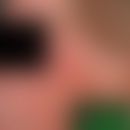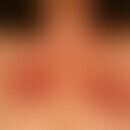Synonym(s)
DefinitionThis section has been translated automatically.
Occurrence/EpidemiologyThis section has been translated automatically.
Nickel is the most frequent allergen in women in the epicutaneous test with a reaction frequency of 13.7%, in men 2.6% show positive reactions (see MOAHLFA index below). Nickel is used in the alloying of metals and can be found in all metal objects, unless they are pure precious metals, such as costume jewellery, watches, spectacle frames, jeans buttons, zippers. Precious metals may also contain nickel. Dental prostheses also contain nickel, as do joint prostheses, medical clips and nails, among other things.
In the cosmetics industry, nickel is used in face and shaving lotions and hair care products. In the detergent industry, catalysts containing nickel are needed. 1 and 2 Euro coins also contain nickel. Nickel is also found in cans, staniol paper and bottle tops and dissolves in food packaged in this way.
Oats, maize, soya, cocoa, chocolate and tea (1-13 µg/g) have a particularly high nickel content. Meat, dairy products, white bread, potatoes, oil (< 1 µg/g), on the other hand, are low in nickel.
You might also be interested in
EtiopathogenesisThis section has been translated automatically.
Allergy to nickel, which is contained in costume jewellery (e.g. piercing), trouser buttons, bras, zippers, garters, corsets, shoe buckles and, in small quantities, in foodstuffs.
Cave! Possible manifestation as an occupational skin disease (possibly in hairdressers, metalworkers, frequent contact with coins).
Genetics: The connection between nickel sensitization and genetic factors (see polymorphism below) is still little researched. The concordance is more pronounced in monozygotes than in dizygotes.
The proportion of filaggrin mutations seems to be higher in nickel contact sensitized patients than in other contact sensitized patients.
It is remarkable that nickel is also directly recognized by T cells during the process of contact sensitization (also MHC-independent). It could be shown that nickel activates the innate immune system via an interaction with the toll-like receptor 4 (TLR4), which initiates the process of contact sensitization.
Oral mucosa: Interesting is an observation in wearers of nickel-containing braces. In this clientele, nickel sensitization is detected less frequently than in a comparable group of patients despite intensive contact in the mucosa. Apparently, braces work like a sublingual immunotherapy!
ClinicThis section has been translated automatically.
- Picture of contact allergic eczema.
- In rare cases, a systemic nickel allergy syndrome (SNAS) may be present with the occurrence of gastro-intestinal complaints after consumption of nickel-containing food (Pföhler 2016). Remark: in allergological consulting hours such problems are more frequently reported (f>m) without a clear connection between the reported symptoms and the diagnostic result. An amalgam allergy is also frequently accused.
DiagnosisThis section has been translated automatically.
Complication(s)(associated diseasesThis section has been translated automatically.
Local or systemic reactions after implantation of nickel-containing osteosynthesis material (see below implant intolerance).
TherapyThis section has been translated automatically.
- Avoid the triggering allergen. Treatment of skin changes, see below allergic contact eczema. nicotine withdrawal (also passive smoking!).
- In cases in which the eczema does not heal completely despite avoiding nickel contact and if the disease is relevant in terms of haematogenically scattering allergic contact eczema, a low-nickel diet should be followed.
- A prior oral provocation with 2.5 (5.0) mg nickel (verum capsule: nickel (II) sulphate 0.0025 g, sacch. lactis ad 0.25 g) should prove to be a useful diagnostic test and, by illustrating the connections, improve the patient's motivation to adhere to a diet. If there is no improvement within 1-2 months, the diet should be discontinued. If there is an improvement (approx. 50%), other nickel exposure may be changed, such as replacing stainless steel pots, whisks etc. with aluminium, enamel and Teflon dishes. The first litre from the water pipe in the morning should be discarded. Many detergents contain traces of nickel. Dietary errors at parties and when travelling should generally be tolerated without any problems. The nickel diet is generally controversial, and its success is also questionable from our point of view.
TablesThis section has been translated automatically.
Low nickel diet (according to Bresser)
|
May be eaten |
Should be avoided |
Meat, fish, etc. |
All types of meat, poultry, fish, eggs, frozen fish |
Larger quantities of offal, herring, shrimps, mussels, canned fish, etc. seafood |
Dairy products |
All dairy products such as butter, cheese, milk (in any form), yogurt |
Larger amounts of Edam cheese, strictly avoid soy milk |
Vegetables |
Beet, broccoli, Brussels sprouts, white cabbage, Chinese cabbage, dill, mushrooms, pepper (red, green), cucumbers, potatoes, parsley, eggplant, asparagus |
Soy products, spinach, legumes (peas, beans green/white/brown, lentils), kale, leeks, bean sprouts, lettuce |
Cereals and cereal products |
All ready-to-eat breakfast cereals, popcorn, white rice, spaghetti, macaroni, white flour products, whole grain products in smaller amounts |
Oatmeal and other oat products, buckwheat, millet, wheat bran and other bran- and fiber-rich foods such as bran bisquits, wheat bran tablets, multigrain breads |
Fruits and berries |
All berries (except raspberries), peaches, pears, raisins, rhubarb |
Figs, pineapples, raspberries, prunes, canned fruits |
Drinks |
Coffee and tea (steeped briefly, not in large quantities), lemonade, alcoholic beverages (except wine and beer) |
drinks containing chocolate and cocoa, tea from vending machines |
Various |
margarine, yeast |
Chocolate, marzipan, cocoa, almonds, hazelnuts, peanuts, flaxseed, soy and soy products, licorice, sunflower seeds, baking powder, canned foods |
Foods low in nickel, which can aggravate eczema (they are often tolerated when cooked) |
Beer, wine (especially red wine), herring, mackerel, tuna, tomatoes, onions, carrots, many fruits (apples, citrus fruits) |
Diet/life habitsThis section has been translated automatically.
Note(s)This section has been translated automatically.
According to a regulation issued by the Health and Consumer Protection Agency in 2000, nickel-containing articles that release more nickel ions than 0.5 µg/cm2/week may no longer be sold. This measure has already led to a significant reduction in nickel allergies in the population.
Evidence between nickel sensitisation and dyshidrotic eczema was demonstrated in a case-control study.
LiteratureThis section has been translated automatically.
- Brehler R et al (1990) Nickel allergy after plate osteosynthesis. Act Dermatol 16: 202-203
- Bryld LE et al (2003) Risk factors influencing the development of hand eczema in a population-based twin sample. Br J Dermatol 149: 1214-1220
- Bresser H (1992) Oral nickel provocation and low nickel diet. dermatologist 43: 610-615
- Erdmann SM et al (2010) Food-borne hematogenic contact dermatitis. Allergo J 19: 264-271
- Fournier PG et al (2003) Contamination by nickel, copper and zinc during the handling of euro coins. Contact dermatitis 48: 181-188
- Gawkrodger DJ (2003) Metal sensitivities and orthopaedic implants revisited: the potential for metal allergy with the new metal-on-metal joint prostheses. Br J Dermatol 148: 1089-1093
- Gölz L et al (2016) Differences in human gingival and dermal fibroblasts may contribute tooral-induced
tolerance against nickel. J Allergy Clin Immunol doi: 10.1016/j.jaci.2016.03.036. - Jensen CS et al (2002) Decrease in nickel sensitization in a Danish schoolgirl population with ears pierced after implementation of a nickel-exposure regulation. Br J Dermatol 146: 636-642
- Lauter H (1994) Nickel allergy and nickel contact eczema. Allergology 17: 470-476
- Novak N et al (2008) Loss-of-function mutations in the filaggrin genes and allergic contact sensitization to nickel. J Invest Dermatol 128: 1430-1435
- Scheller R et al (1988) Food chemistry and technology aspects of low-nickel nutrition in endogenously caused allergic contact eczema. dermatologist 39: 491-497
- Schnuch A (2011) Genetics of contact allergy. dermatologist 62: 732-738
- Schnuch A et al (2003) Decrease in nickel allergy in Germany and regulatory interventions. Contact Dermatitis 49: 107-108
- Uter W et al (1999) The MOAHLFA index in 17 centers of the Information Network of Departments of Dermatology (IVDK) over 6 years. Contact Dermatitis 41: 343-344
- Zhai H et al (2003) Provocative use test of nickel coins in nickel-sensitized subjects and controls. Br J Dermatol 149: 311-317
Incoming links (10)
Contact allergens; Contact allergy, genetics; Contact dermatitis haematogenic; Contact dermatitis lymphomatoids; Dyshidrotic dermatitis; FLG Gene; Hematogenic contact dermatitis; Moahlfa index; Systemic nickel allergy syndrome; Watchband dermatitis;Outgoing links (16)
Allergy (overview); Amalgam allergy; Buckwheat; Contact allergy, monovalent; Contact dermatitis allergic; Dyshidrotic dermatitis; Eczema (overview); Epicutaneous test; Filaggrine; Hematogenic contact dermatitis; ... Show allDisclaimer
Please ask your physician for a reliable diagnosis. This website is only meant as a reference.





